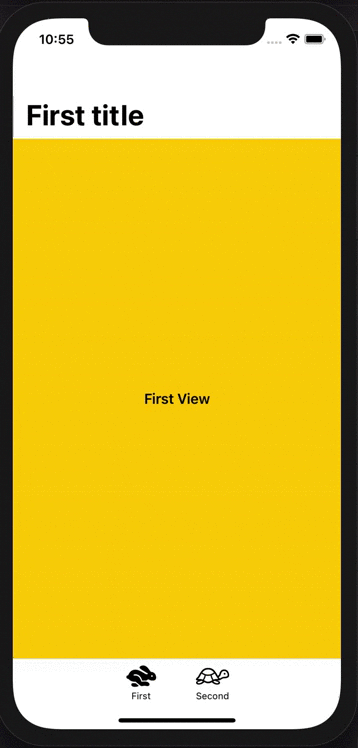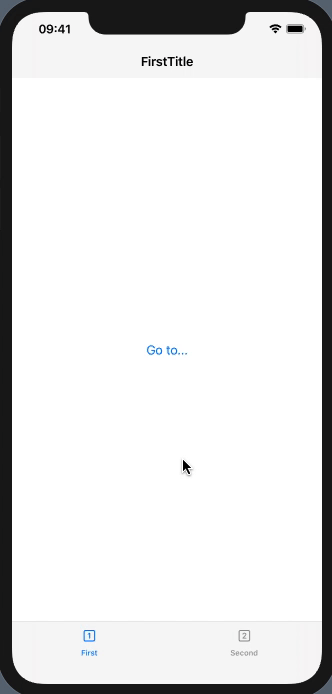SwiftUI Hide TabView bar inside NavigationLink views
I really enjoyed the solutions posted above, but I don't like the fact that the TabBar is not hiding according to the view transition. In practice, when you swipe left to navigate back when using tabBar.isHidden, the result is not acceptable.
I decided to give up the native SwiftUI TabView and code my own. The result is more beautiful in the UI:

Here is the code used to reach this result:
First, define some views:
struct FirstView: View {
var body: some View {
NavigationView {
VStack {
Text("First View")
.font(.headline)
}
.navigationTitle("First title")
.frame(minWidth: 0, maxWidth: .infinity, minHeight: 0, maxHeight: .infinity, alignment: .center)
.background(Color.yellow)
}
}
}
struct SecondView: View {
var body: some View {
VStack {
NavigationLink(destination: ThirdView()) {
Text("Second View, tap to navigate")
.font(.headline)
}
}
.navigationTitle("Second title")
.frame(minWidth: 0, maxWidth: .infinity, minHeight: 0, maxHeight: .infinity, alignment: .center)
.background(Color.orange)
}
}
struct ThirdView: View {
var body: some View {
VStack {
Text("Third View with tabBar hidden")
.font(.headline)
}
.frame(minWidth: 0, maxWidth: .infinity, minHeight: 0, maxHeight: .infinity, alignment: .center)
.background(Color.red.edgesIgnoringSafeArea(.bottom))
}
}
Then, create the TabBarView (which will be the root view used in your app):
struct TabBarView: View {
enum Tab: Int {
case first, second
}
@State private var selectedTab = Tab.first
var body: some View {
VStack(spacing: 0) {
ZStack {
if selectedTab == .first {
FirstView()
}
else if selectedTab == .second {
NavigationView {
VStack(spacing: 0) {
SecondView()
tabBarView
}
}
}
}
.animation(nil)
if selectedTab != .second {
tabBarView
}
}
}
var tabBarView: some View {
VStack(spacing: 0) {
Divider()
HStack(spacing: 20) {
tabBarItem(.first, title: "First", icon: "hare", selectedIcon: "hare.fill")
tabBarItem(.second, title: "Second", icon: "tortoise", selectedIcon: "tortoise.fill")
}
.padding(.top, 8)
}
.frame(height: 50)
.background(Color.white.edgesIgnoringSafeArea(.all))
}
func tabBarItem(_ tab: Tab, title: String, icon: String, selectedIcon: String) -> some View {
ZStack(alignment: .topTrailing) {
VStack(spacing: 3) {
VStack {
Image(systemName: (selectedTab == tab ? selectedIcon : icon))
.font(.system(size: 24))
.foregroundColor(selectedTab == tab ? .primary : .black)
}
.frame(width: 55, height: 28)
Text(title)
.font(.system(size: 11))
.foregroundColor(selectedTab == tab ? .primary : .black)
}
}
.frame(width: 65, height: 42)
.onTapGesture {
selectedTab = tab
}
}
}
This solution also allows a lot of customization in the TabBar. You can add some notifications badges, for example.
If we talk about standard TabView, the possible workaround solution can be based on TabBarAccessor from my answer on Programmatically detect Tab Bar or TabView height in SwiftUI
Here is a required modification in tab item holding NavigationView. Tested with Xcode 11.4 / iOS 13.4

struct FirstTabView: View {
@State private var tabBar: UITabBar! = nil
var body: some View {
NavigationView {
NavigationLink(destination:
FirstChildView()
.onAppear { self.tabBar.isHidden = true } // !!
.onDisappear { self.tabBar.isHidden = false } // !!
) {
Text("Go to...")
}
.navigationBarTitle("FirstTitle", displayMode: .inline)
}
.background(TabBarAccessor { tabbar in // << here !!
self.tabBar = tabbar
})
}
}
Note: or course if FirstTabView should be reusable and can be instantiated standalone, then tabBar property inside should be made optional and handle ansbsent tabBar explicitly.
How about,
struct TabSelectionView: View {
@State private var currentTab: Tab = .Scan
private enum Tab: String {
case Scan, Validate, Settings
}
var body: some View {
TabView(selection: $currentTab){
ScanView()
.tabItem {
Label(Tab.Scan.rawValue, systemImage: "square.and.pencil")
}
.tag(Tab.Scan)
ValidateView()
.tabItem {
Label(Tab.Validate.rawValue, systemImage: "list.dash")
}
.tag(Tab.Validate)
SettingsView()
.tabItem {
Label(Tab.Settings.rawValue, systemImage: "list.dash")
}
.tag(Tab.Settings)
}
.navigationBarTitle(Text(currentTab.rawValue), displayMode: .inline)
}
}
Thanks to another Asperi's answer I was able to find a solution which does not break animations and looks natural.
struct ContentView: View {
@State private var tabSelection = 1
var body: some View {
NavigationView {
TabView(selection: $tabSelection) {
FirstView()
.tabItem {
Text("1")
}
.tag(1)
SecondView()
.tabItem {
Text("2")
}
.tag(2)
}
// global, for all child views
.navigationBarTitle(Text(navigationBarTitle), displayMode: .inline)
.navigationBarHidden(navigationBarHidden)
.navigationBarItems(leading: navigationBarLeadingItems, trailing: navigationBarTrailingItems)
}
}
}
struct FirstView: View {
var body: some View {
NavigationLink(destination: Text("Some detail link")) {
Text("Go to...")
}
}
}
struct SecondView: View {
var body: some View {
Text("We are in the SecondView")
}
}
Compute navigationBarTitle and navigationBarItems dynamically:
private extension ContentView {
var navigationBarTitle: String {
tabSelection == 1 ? "FirstView" : "SecondView"
}
var navigationBarHidden: Bool {
tabSelection == 3
}
@ViewBuilder
var navigationBarLeadingItems: some View {
if tabSelection == 1 {
Text("+")
}
}
@ViewBuilder
var navigationBarTrailingItems: some View {
if tabSelection == 1 {
Text("-")
}
}
}